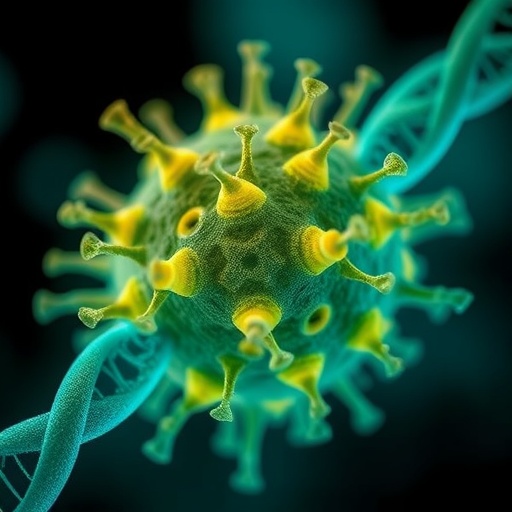In a groundbreaking study poised to revolutionize the field of synthetic biology and genetic code expansion, researchers have unveiled a novel strategy for the intracellular delivery of non-canonical amino acids (ncAAs) in Escherichia coli. This innovative approach leverages the promiscuous substrate recognition capabilities of the bacterial ABC transporter OppA, hijacking its natural peptide uptake pathway to facilitate efficient import and incorporation of a broad spectrum of ncAAs. The findings, reported in a recent publication in Nature, provide a versatile and powerful tool for engineering proteins with novel functionalities, potentially transforming biomedical research and biotechnology.
At the core of this advance lies the meticulous exploration of OppA’s binding pocket, revealed by high-resolution crystallographic data showing a spacious cavity capable of accommodating peptide substrates extending from the serine side chain to the N-terminal glycine residue. This insight sparked a hypothesis that the transporter’s substrate flexibility could extend to non-canonical side chains beyond the natural amino acid repertoire, thus enabling the shuttling of diverse synthetic peptides conjugated with ncAAs into the bacterial cytosol.
To test this concept, the researchers designed and synthesized a panel of 14 tripeptides with a generic scaffold designated Z-AisoK, wherein Z represents varied amino acid residues, including both canonical and non-canonical entities. These Z residues were strategically positioned at the N-terminus to probe the structural tolerance of OppA for bulkier or chemically distinct side chains. Importantly, the incorporation of these Z-AisoK tripeptides into cells led to the intracellular generation of both the liberated Z residue and the bio-orthogonal amino acid AisoK.
Functional validation was carried out by measuring the amber suppression efficiency using a reporter system involving sfGFP (superfolder green fluorescent protein) harboring an amber stop codon at position 150. Successful suppression, indicative of ncAA incorporation, was observed for over half of the synthesized tripeptides in wild-type E. coli K12, demonstrating the viability of this transport-mediated delivery route. Supplementary liquid chromatography-mass spectrometry (LC-MS) confirmed the presence of AisoK within expressed proteins, ensuring that surface-level fluorescence data were consistent with bona fide incorporation.
However, the strategy faced challenges with tripeptides containing bulkier or negatively charged Z residues, which exhibited poor or negligible uptake and cleavage, as evidenced by dramatically reduced amber suppression efficiency. This limitation led the team to engineer the OppA transporter itself through directed evolution techniques, targeting four amino acid residues surrounding the glycine moiety in the G-SisoK substrate to expand binding pocket dimensions and enhance accommodation of larger or charged side chains.
This rational mutagenesis, combined with three rounds of fluorescence-activated cell sorting (FACS) enrichment, yielded two evolved transporter variants, coined OppA-Z1 and OppA-Z2, each tailored to different subsets of challenging substrates. Both variants featured reduced side chain bulkiness at critical positions, enlarging the pocket, while OppA-Z2 uniquely harbored a spontaneous R439H mutation that likely contributed to improved affinity for isopeptide-linked substrates. The engineered E. coli strains expressing these variants demonstrated marked improvements in the uptake and subsequent incorporation of previously impermeable ncAA-bearing peptides.
The most significant breakthrough was observed with OppA-Z2-expressing cells, which efficiently internalized all tested Z-AisoK tripeptides, including those with negatively charged residues such as succinyl-lysine and glutamyl-lysine analogs. This finding underscores the broad substrate scope achievable through transporter engineering, significantly widening the chemical diversity accessible for genetic code expansion in living bacterial systems. The ability to utilize charged and bulky ncAAs intracellularly opens exciting avenues for the creation of proteins with complex, post-translationally modified-like features that were previously inaccessible.
Comparative analyses between direct supplementation with free ncAAs and peptide conjugates illuminated the superior performance of the latter, particularly for low-permeability amino acids. For example, acetyl-lysine (AcK) presented enhanced incorporation efficiency when delivered as a Z-AisoK tripeptide compared to free AcK, highlighting the critical role of active transport in overcoming cellular membrane barriers. Remarkably, the delivery of lipoyl-lysine (LipK), a notably bulky ncAA with minimal cell permeability, was nearly undetectable via direct supplementation but became highly efficient in OppA-Z1 strains supplemented with the corresponding tripeptide. These results demonstrate that transporter-enabled import can surmount permeation bottlenecks, facilitating reliable and scalable ncAA incorporation.
Additionally, the study showcased the power of combining this uptake strategy with evolved aminoacyl-tRNA synthetase (aaRS)/tRNA pairs specific for respective ncAAs, achieving synthetase-promoted activation and incorporation inside the cell. Furthermore, the team demonstrated dual stop codon suppression utilizing a single isopeptide-linked tripeptide delivering two distinct ncAAs simultaneously, underscoring the method’s flexibility for multi-site protein engineering.
The implications of hijacking bacterial peptide transport for ncAA delivery extend far beyond laboratory protein synthesis. This technology paves the way for advanced synthetic biology applications, including the design of proteins with unnatural post-translational modifications, incorporation of chemical handles for bioorthogonal conjugation, and the production of novel therapeutics with enhanced stability, targeting, or novel mechanisms of action.
Future directions inspired by this research include further tailoring of peptide transporters to shuttle even more diverse chemical entities, exploring alternative bacterial hosts to extend the platform’s utility, and coupling this uptake mechanism with genome-integrated biosynthetic pathways for complete in vivo ncAA production and incorporation. The modularity of the Z-AisoK scaffold promises to be a versatile foundation for next-generation genetic code expansion efforts.
This study represents a compelling leap in our capacity to manipulate the proteome with precision and breadth, overcoming previous limitations imposed by cellular uptake and synthetic amino acid availability. By ingeniously co-opting natural bacterial transport mechanisms and enhancing them via protein engineering, the researchers have opened a new frontier in synthetic protein science, destined to reshape horizons across molecular biology, biotechnology, and medicine.
Subject of Research: Bacterial ABC transporters for genetic code expansion
Article Title: Hijacking a bacterial ABC transporter for genetic code expansion
Article References:
Iype, T., Fottner, M., Böhm, P. et al. Hijacking a bacterial ABC transporter for genetic code expansion. Nature (2025). https://doi.org/10.1038/s41586-025-09576-w




